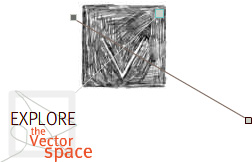Public Secrets
Design by Erik Loyer
Editor's Introduction
To many, central California is perhaps best known as the heart of a large agriculture business, a vast terrain of plowed fields abutting the state's main thoroughfare, the I-5. Less obvious from the confines of the freeway is another rapidly expanding industry within the region, the state's massive prison system. As Sharon Daniel narrates in the voice over that opens this project, a thirty square mile area near Chowchilla houses three prisons, including the two largest women's prisons in the world. Public Secrets reconfigures the physical, psychological, and ideological spaces of the prison, allowing us to learn about life inside the prison along several thematic pathways and from multiple points of view. Through a thoughtful and respectful framing and layering of the voices of individual women, we get a view from inside but also a view in context.
Moving through the many voices brought together here, you are asked to listen with care to new points of view and to examine prisons from the inside out. The piece seeks to dispel popular misconceptions about the nature of prisons and those incarcerated within them, offering compelling evidence of the violence and abuse that such systems perpetuate by their very nature. As Jane Dorotik observes within the piece, "It is a story I knew nothing about until I was sent here." While much of the piece highlights the voices and experiences of individual women, the networked structure of the project and the women themselves insist that we understand the prison industrial complex as a social problem that impacts us all, its dehumanizing effects spiraling out to call into question the basic principles underpinning any just and democratic society. Public Secrets asks us each to realize that the prison system diminishes us all.
The very design of the project -- its algorithmic structure -- calls our attention to the shifting borders between inside and outside, incarceration and freedom, oppression and resistance, despair and hope. Throughout your navigation of the piece, the fine lines demarcating such binaries will morph, shift, and reconfigure, calling any easy assumptions about 'us' and 'them' into
question. Rather, inside and outside mutually determine and construct one another, sketching powerful vectors of relation between individual experiences and broader social systems.
From the very first design meetings in support of this piece, Sharon Daniel has consistently described her work with incarcerated women as an abolitionist project; that is, Public Secrets is part of a larger resistance movement that aims to dismantle the prison system in pursuit of a more humane world. As the activist organization with which Daniel works, Justice Now, announces on its website, "we believe in working toward a society that no longer relies on prisons but instead invests resources in making communities stronger." It is hard to come away from a sustained engagement with this project and not be moved toward that goal, undergoing a kind of conversion experience that profoundly re-jiggers one's perception.
What function does the three million dollar razor wire fence at the California Correctional Women's Facility serve? Certainly, it keeps people 'in' the prison, but perhaps, more crucially, it gives society an easy 'out,' functioning as a convenient screen for our disavowals about systemic injustice, social inequality, and the crippling effects of poverty. "Public Secrets" powerfully reveals the costs -- both personal and social -- of such projections and denials.



